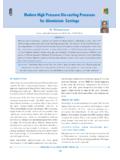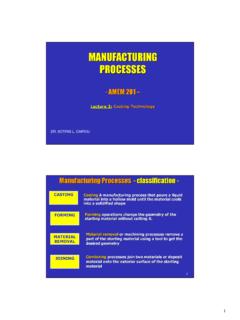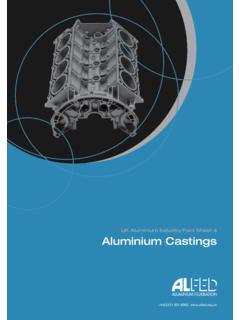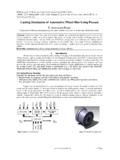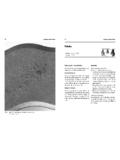Transcription of Casting Defects and Design Issues - Precision Die Casting
1 Casting Defects and Design Issues ver. 2. ME 6222: Manufacturing processes and Systems 1. Prof. Colton GIT 2011. Overview processes Analysis Defects Design rules Economics ME 6222: Manufacturing processes and Systems 2. Prof. Colton GIT 2011. Issues in Casting Shrinkage Porosity Piping Microstructure ME 6222: Manufacturing processes and Systems 3. Prof. Colton GIT 2011. Shrinkage Can amount to 5-10% by volume Gray cast iron expands upon solidification due to phase changes Need to Design part and mold to take this amount into consideration ME 6222: Manufacturing processes and Systems 4. Prof. Colton GIT 2011. Shrinkage TABLE Volumetric Volumetric solidification solidification Metal or alloy contraction (%) Metal or alloy contraction (%).
2 Aluminum 70%Cu 30%Zn Al 90%Cu 10%Al 4. Al 12%Si Gray iron Expansion to Carbon steel 3 Magnesium 1% carbon steel 4 White iron 4 Copper Zinc Source: After R. A. Flinn. ME 6222: Manufacturing processes and Systems 5. Prof. Colton GIT 2011. Casting Defects ME 6222: Manufacturing processes and Systems 6. Prof. Colton GIT 2011. Defects - Hot Tears ME 6222: Manufacturing processes and Systems 7. Prof. Colton GIT 2011. Steam Engine Flywheels ME 6222: Manufacturing processes and Systems 8. Prof. Colton GIT 2011. Car Rims Stamped Cast ME 6222: Manufacturing processes and Systems 9. Prof. Colton GIT 2011. Casting Defects - Porosity ME 6222: Manufacturing processes and Systems 10. Prof. Colton GIT 2011. Porosity Types due to gases smooth bubbles due to shrinkage rough voids Not a problem for ingots parts that will be deformation processed as long as it is not exposed to air (corrosion).
3 Can be healed ME 6222: Manufacturing processes and Systems 11. Prof. Colton GIT 2011. Porosity due to Gases Smooth bubbles result from entrapped gases solubility in liquid is high, in solid is low, so gas is rejected during cooling Sievert's law S = S = solubility k = constant pg = partial pressure of gas over melt ME 6222: Manufacturing processes and Systems 12. Prof. Colton GIT 2011. Remedies for Gas Bubbles Control atmosphere vacuum gases with less solubility Proper venting to let gases out Proper Design of runners and gates to avoid turbulence ME 6222: Manufacturing processes and Systems 13. Prof. Colton GIT 2011. Remedies for Gas Bubbles Add metallic elements to react with gases killed steels - highly deoxidized (Al, Si).
4 High shrinkage due to gas removal - piping semi-killed steels - less deoxidized less piping, porosity rimmed steels - little deoxidization blow holes in ring at rim (sometimes break through). little piping because gas doesn't escape ME 6222: Manufacturing processes and Systems 14. Prof. Colton GIT 2011. Porosity due to Shrinkage Rough bubbles - voids Stages cooling liquid rejects latent heat at melting point alloys become slushy - liquid and solid co-exist cooling solid ME 6222: Manufacturing processes and Systems 15. Prof. Colton GIT 2011. Differential Cooling Transition between thicker and thinner sections can lead to porosity ME 6222: Manufacturing processes and Systems 16. Prof. Colton GIT 2011. Porosity / Shrinkage Solutions Risers allow molten metal to flow into mold to make up for shrinkage Design flow so no part freezes early large channels Flexible molds allow metal to shrink, not hold metal ME 6222: Manufacturing processes and Systems 17.
5 Prof. Colton GIT 2011. Porosity / Shrinkage Solutions Heating or cooling certain areas to maintain uniform cooling (thermit or chills). Uniform part thickness leads to uniform cooling, less residual stress ME 6222: Manufacturing processes and Systems 18. Prof. Colton GIT 2011. Chills ME 6222: Manufacturing processes and Systems 19. Prof. Colton GIT 2011. Pipe Defect Due to shrinkage giving rise to a funnel-like cavity Solutions insulate top (glass wool). heat top (exothermic mixture - thermit). ME 6222: Manufacturing processes and Systems 20. Prof. Colton GIT 2011. Microstructure ME 6222: Manufacturing processes and Systems 21. Prof. Colton GIT 2011. Grains on Willie B's head ME 6222: Manufacturing processes and Systems 22.
6 Prof. Colton GIT 2011. Microstructure - Dendrites Finer structure at walls Grains / dendrites grow to center ME 6222: Manufacturing processes and Systems 23. Prof. Colton GIT 2011. Microstructure - Dendrites ME 6222: Manufacturing processes and Systems 24. Prof. Colton GIT 2011. Microstructure Post-treatment may be necessary to get desired properties - grain structure annealing tempering cold working ME 6222: Manufacturing processes and Systems 25. Prof. Colton GIT 2011. Design Rules Summary Uniform wall thickness Flat parting lines Gradual thickness transitions Draft for removal tapers: to 2 degrees Surface of mold gives surface of part ME 6222: Manufacturing processes and Systems 26. Prof. Colton GIT 2011. Sand Casting Rules ME 6222: Manufacturing processes and Systems 27.
7 Prof. Colton GIT 2011. Economics Example - Optical Bench ME 6222: Manufacturing processes and Systems 28. Prof. Colton GIT 2011. Requirements Casting of Al-Si alloy Number one-off preliminary run (100). production run (10,000). High Precision required machining required pick cheapest Casting method ME 6222: Manufacturing processes and Systems 29. Prof. Colton GIT 2011. Alternative processes Sand Casting Low pressure Casting Permanent mold Casting Die Casting ME 6222: Manufacturing processes and Systems 30. Prof. Colton GIT 2011. Cost Equation Cc CL. C = Cm + +. n n&. C = cost/part Cm = material cost Cc = capital cost CL = labor cost n = number produced n& = production rate ME 6222: Manufacturing processes and Systems 31. Prof.
8 Colton GIT 2011. Process Costs Process Sand Low Permanent Die Casting Casting Pressure Mold Material, Cm ($) 1 1 1 1. Labor, CL ($/hr) 20 20 20 20. Capital, CC ($) 700 3000. Rate, n& (#/hr) 22 10 50. ME 6222: Manufacturing processes and 32. Systems Prof. Colton GIT 2011. Process Economics ME 6222: Manufacturing processes and Systems 33. Prof. Colton GIT 2011. Process Selection Probably pick low pressure Casting , as a preliminary run of 100 is assured. If production run is needed, die Casting will probably be used. The tough part is getting the process cost data. ME 6222: Manufacturing processes and Systems 34. Prof. Colton GIT 2011. Production of Aluminum Auto Parts Main Casting Low-Pressure High-Pressure Squeeze A B D. Characteristic Gravity Die Casting Die Casting Casting C.
9 (Pores Free). Pouring/Filling Ladle Air pressure High-speed and Relatively low- Method through stalk high-pressure speed and injection by high-pressure hydraulic piston injection Filling Time (s) 10-30 10-30 1 10. Operating 1 1+( ) 100-500 500-1,000. Pressure (atm.). Cycle Time 5-10 5-10 1-2 2. (min.). Die/Mold High High Low Low-medium Temperature Dimensional + ++ +++ +++. Accuracy Design +++ ++ + +. Availability Productivity + ++ +++ +++. Quality + ++ +-+++ +++. Cost + + +++ +++. Machining Many Many Few Few Required Main Parts Intake manifold, Cylinder block, Cylinder block, Piston, disk- (other than cylinder block cylinder head, oil pan, cylinder brake caliper, wheels) and head, suspension, head cover, power steering piston member transaxle case toe control hub, knuckle ME 6222: Manufacturing processes and 35.
10 Systems Prof. Colton GIT 2011. Advantages of Casting Near- or net- shape Less scrap Intricate shapes Large hollow shapes No limit to size ME 6222: Manufacturing processes and Systems 36. Prof. Colton GIT 2011. Disadvantages of Casting Shrinkage, porosity, cracks No strain hardening can be brittle Tooling can be expensive part shape depends on tool (mold). Microstructure can be difficult to control non-uniform cooling faster on outside produces finer grain structure there ME 6222: Manufacturing processes and Systems 37. Prof. Colton GIT 2011. Summary Defects Design rules Economics ME 6222: Manufacturing processes and Systems 38. Prof. Colton GIT 2011. ME 6222: Manufacturing processes and Systems 39. Prof. Colton GIT 2011.
